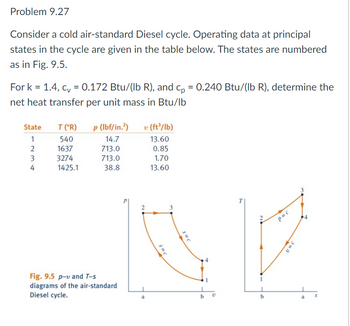
Elements Of Electromagnetics
7th Edition
ISBN: 9780190698614
Author: Sadiku, Matthew N. O.
Publisher: Oxford University Press
expand_more
expand_more
format_list_bulleted
Question
Problem 9.27
Consider a cold air-standard Diesel cycle. Operating data at principal states in the cycle are given in the table below. The states are numbered as in Fig. 9.5.
For k = 1.4, cv = 0.172 Btu/(lb R), and cp = 0.240 Btu/(lb R), (a) determine the net heat transfer per unit mass in Btu/lb. (b) Determine the net work per unit mass in Btu/lb. (c) Determine the cycle thermal efficiency (%)

Transcribed Image Text:Problem 9.27
Consider a cold air-standard Diesel cycle. Operating data at principal
states in the cycle are given in the table below. The states are numbered
as in Fig. 9.5.
For k = 1.4, cv = 0.172 Btu/(lb R), and cp = 0.240 Btu/(lb R), determine the
net heat transfer per unit mass in Btu/lb
State
1
2
3
4
T (°R) p (lbf/in.²)
540
14.7
1637
713.0
3274
713.0
1425.1
38.8
Fig. 9.5 p-v and T-s
diagrams of the air-standard
Diesel cycle.
v (ft3/lb)
13.60
0.85
1.70
13.60
N
a
S=C
3
S=C
b
V
2
b
p=c
V=C
T
a
Expert Solution
This question has been solved!
Explore an expertly crafted, step-by-step solution for a thorough understanding of key concepts.
This is a popular solution
Trending nowThis is a popular solution!
Step by stepSolved in 5 steps with 5 images

Knowledge Booster
Similar questions
- I only need help with letters (c) and (d). At the beginning of the compression process of an air-standard Otto cycle, p1 = 1 bar and T1 = 300 K. The compression ratio is 6 and the heat addition per unit mass of air is 1200 kJ/kg. Determine:(a) the maximum temperature of the cycle, in K.(b) the net work, in kJ/kg.(c) the percent thermal efficiency of the cycle.(d) the mean effective pressure, in kPa.arrow_forwardAt the beginning of the compression process of an air-standard Otto cycle, p1 = 1 bar and T1 = 300 K. The compression ratio is 8.5 and the heat addition per unit mass of air is 1400 kJ/kg.Determine:(a) the maximum temperature of the cycle, in K.(b) the net work, in kJ/kg.(c) the percent thermal efficiency of the cycle.(d) the mean effective pressure, in kPa.arrow_forward1- For modeling a gas turbine power plant producing 10 MW of power, the ideal air-standard Brayton cycle operating at steady state is used. Operating data at principal states in the cycle are given in the table below. The states are numbered as in Fig. below. (a) Sketch the T–s diagram for the cycle and determine (b) the mass flow rate of air, in kg/s, (c) the rate of heat transfer, in kW, to the working fluid passing through the heat exchanger, (d) the thermal efficiency.arrow_forward
arrow_back_ios
arrow_forward_ios
Recommended textbooks for you
 Elements Of ElectromagneticsMechanical EngineeringISBN:9780190698614Author:Sadiku, Matthew N. O.Publisher:Oxford University Press
Elements Of ElectromagneticsMechanical EngineeringISBN:9780190698614Author:Sadiku, Matthew N. O.Publisher:Oxford University Press Mechanics of Materials (10th Edition)Mechanical EngineeringISBN:9780134319650Author:Russell C. HibbelerPublisher:PEARSON
Mechanics of Materials (10th Edition)Mechanical EngineeringISBN:9780134319650Author:Russell C. HibbelerPublisher:PEARSON Thermodynamics: An Engineering ApproachMechanical EngineeringISBN:9781259822674Author:Yunus A. Cengel Dr., Michael A. BolesPublisher:McGraw-Hill Education
Thermodynamics: An Engineering ApproachMechanical EngineeringISBN:9781259822674Author:Yunus A. Cengel Dr., Michael A. BolesPublisher:McGraw-Hill Education Control Systems EngineeringMechanical EngineeringISBN:9781118170519Author:Norman S. NisePublisher:WILEY
Control Systems EngineeringMechanical EngineeringISBN:9781118170519Author:Norman S. NisePublisher:WILEY Mechanics of Materials (MindTap Course List)Mechanical EngineeringISBN:9781337093347Author:Barry J. Goodno, James M. GerePublisher:Cengage Learning
Mechanics of Materials (MindTap Course List)Mechanical EngineeringISBN:9781337093347Author:Barry J. Goodno, James M. GerePublisher:Cengage Learning Engineering Mechanics: StaticsMechanical EngineeringISBN:9781118807330Author:James L. Meriam, L. G. Kraige, J. N. BoltonPublisher:WILEY
Engineering Mechanics: StaticsMechanical EngineeringISBN:9781118807330Author:James L. Meriam, L. G. Kraige, J. N. BoltonPublisher:WILEY

Elements Of Electromagnetics
Mechanical Engineering
ISBN:9780190698614
Author:Sadiku, Matthew N. O.
Publisher:Oxford University Press

Mechanics of Materials (10th Edition)
Mechanical Engineering
ISBN:9780134319650
Author:Russell C. Hibbeler
Publisher:PEARSON

Thermodynamics: An Engineering Approach
Mechanical Engineering
ISBN:9781259822674
Author:Yunus A. Cengel Dr., Michael A. Boles
Publisher:McGraw-Hill Education

Control Systems Engineering
Mechanical Engineering
ISBN:9781118170519
Author:Norman S. Nise
Publisher:WILEY

Mechanics of Materials (MindTap Course List)
Mechanical Engineering
ISBN:9781337093347
Author:Barry J. Goodno, James M. Gere
Publisher:Cengage Learning

Engineering Mechanics: Statics
Mechanical Engineering
ISBN:9781118807330
Author:James L. Meriam, L. G. Kraige, J. N. Bolton
Publisher:WILEY